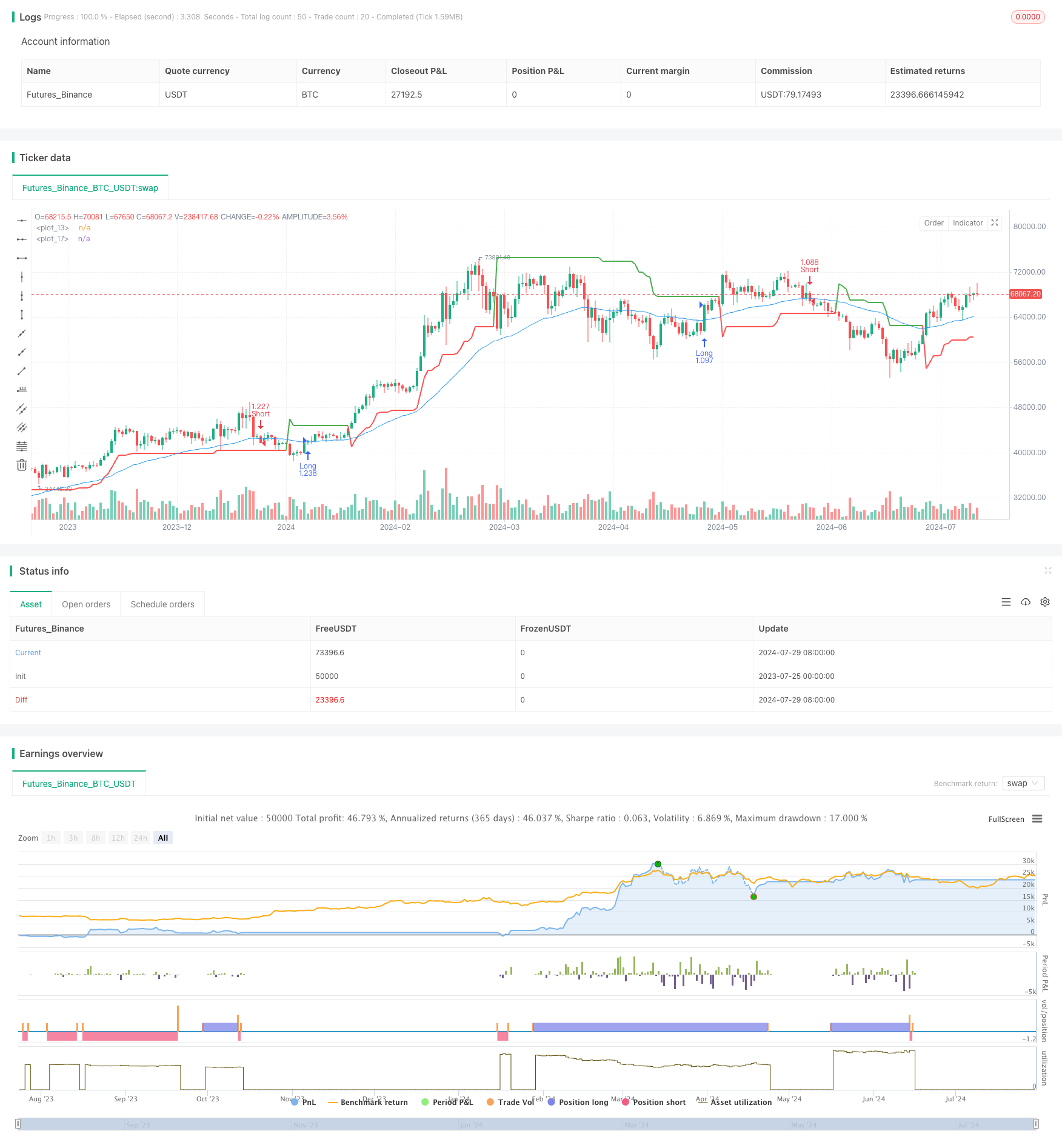
概述
本文介绍了一种基于Supertrend指标和指数移动平均线(EMA)交叉的量化交易策略。该策略结合了趋势跟踪和均线交叉的优势,旨在捕捉市场趋势并在趋势反转时及时进行交易。策略使用Supertrend指标识别整体趋势方向,同时利用44周期EMA作为入场和出场的参考线。通过设置1%的止盈和止损,策略可以有效控制风险并锁定利润。
策略原理
Supertrend指标计算:
- 使用10周期的ATR(真实波幅)和3.0的因子计算Supertrend。
- Supertrend的方向用于确定整体趋势(正值表示上涨趋势,负值表示下跌趋势)。
44周期EMA计算:
- 使用44个周期的收盘价计算指数移动平均线。
入场条件:
- 多头入场:价格向上穿越44EMA且Supertrend方向为正。
- 空头入场:价格向下穿越44EMA且Supertrend方向为负。
出场条件:
- 使用strategy.exit函数设置1%的止盈和1%的止损。
- 多头:止盈价为入场价格的101%,止损价为入场价格的99%。
- 空头:止盈价为入场价格的99%,止损价为入场价格的101%。
仓位管理:
- 使用strategy.risk.max_position_size(1)限制最大持仓为1。
策略优势
趋势跟踪与均线交叉结合:
- Supertrend提供整体趋势方向,减少逆势交易。
- EMA交叉提供更精确的入场时机,提高交易成功率。
风险控制:
- 设置固定百分比的止盈和止损,有效控制每笔交易的风险。
- 最大持仓限制防止过度杠杆。
适应性强:
- 可以通过调整Supertrend和EMA参数适应不同市场和时间框架。
自动化交易:
- 策略可以在TradingView平台上自动执行,减少人为干预。
清晰的交易信号:
- 入场和出场条件明确,易于理解和执行。
策略风险
震荡市场表现不佳:
- 在横盘或震荡市场中可能产生频繁的假信号,导致连续亏损。
滞后性:
- EMA和Supertrend都是滞后指标,可能错过趋势的早期阶段。
固定止盈止损的局限性:
- 1%的固定止盈止损可能不适合所有市场条件,尤其是在波动性较大的市场中。
过度依赖技术指标:
- 未考虑基本面因素和市场情绪,可能在重大新闻或事件发生时表现不佳。
回撤风险:
- 在强势趋势中,1%的止损可能导致过早退出有利交易。
策略优化方向
动态止盈止损:
- 考虑使用ATR或波动率百分比来设置动态止盈止损,以适应不同的市场条件。
增加过滤器:
- 引入成交量、波动率或其他技术指标作为额外的过滤条件,减少假信号。
多时间框架分析:
- 结合更高时间框架的趋势分析,提高交易方向的准确性。
优化参数:
- 使用历史数据回测不同的Supertrend和EMA参数,找到最优组合。
加入基本面分析:
- 考虑重要经济数据发布或公司财报等基本面因素,在特定时期调整策略。
改进仓位管理:
- 实施更复杂的仓位管理策略,如基于账户净值的百分比或Kelly准则。
增加趋势强度过滤:
- 使用ADX或类似指标评估趋势强度,只在强趋势中交易。
总结
Supertrend和EMA交叉量化交易策略是一个结合了趋势跟踪和均线交叉的自动化交易系统。通过Supertrend指标识别整体趋势方向,并利用44周期EMA的交叉作为具体的入场和出场信号,该策略旨在捕捉中长期市场趋势。1%的固定止盈止损设置为策略提供了风险管理框架,但也可能限制了在波动性较大市场中的表现。
该策略的主要优势在于其清晰的交易逻辑和自动化执行能力,适合那些寻求系统化交易方法的投资者。然而,策略也存在一些潜在风险,如在震荡市场中的表现不佳和对技术指标的过度依赖。
为了进一步提高策略的稳健性和适应性,可以考虑引入动态止盈止损机制、多重时间框架分析、额外的过滤条件以及更复杂的仓位管理技术。同时,结合基本面分析和市场情绪指标也可能有助于提高策略的整体表现。
总的来说,这是一个基础但潜力巨大的量化交易策略,通过持续优化和测试,它有望成为一个可靠的自动化交易系统。投资者在使用此策略时,应当充分了解其优势和局限性,并根据个人风险承受能力和市场环境进行适当调整。
/*backtest
start: 2023-07-25 00:00:00
end: 2024-07-30 00:00:00
period: 1d
basePeriod: 1h
exchanges: [{"eid":"Futures_Binance","currency":"BTC_USDT"}]
*/
// This Pine Script™ code is subject to the terms of the Mozilla Public License 2.0 at https://mozilla.org/MPL/2.0/
// © ANKITKEDIA2022
//@version=5
strategy("Supertrend and 44 EMA Strategy", overlay=true, default_qty_type=strategy.percent_of_equity, default_qty_value=100)
// Inputs for Supertrend
atrPeriod = input.int(10, title="ATR Period")
factor = input.float(3.0, title="Factor")
// Supertrend calculation
[supertrend, direction] = ta.supertrend(factor, atrPeriod)
plot(supertrend, color=direction > 0 ? color.green : color.red, linewidth=2)
// 44 EMA calculation
ema44 = ta.ema(close, 44)
plot(ema44, color=color.blue, linewidth=1)
// Entry and exit conditions
longCondition = ta.crossover(close, ema44) and direction > 0
shortCondition = ta.crossunder(close, ema44) and direction < 0
// Target and Stop Loss
strategy.risk.max_position_size(1)
targetPercent = 0.01
stopPercent = 0.01
if (longCondition)
strategy.entry("Long", strategy.long)
strategy.exit("Take Profit/Stop Loss", from_entry="Long", limit=close * (1 + targetPercent), stop=close * (1 - stopPercent))
if (shortCondition)
strategy.entry("Short", strategy.short)
strategy.exit("Take Profit/Stop Loss", from_entry="Short", limit=close * (1 - targetPercent), stop=close * (1 + stopPercent))